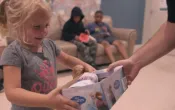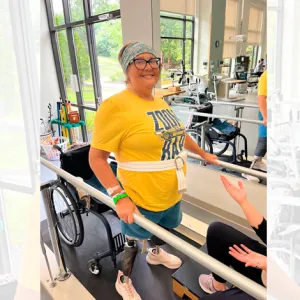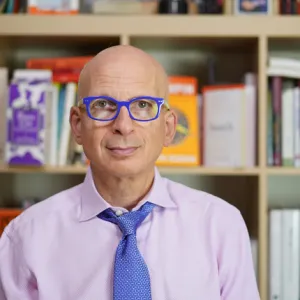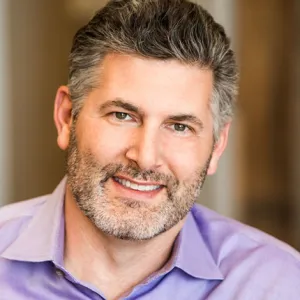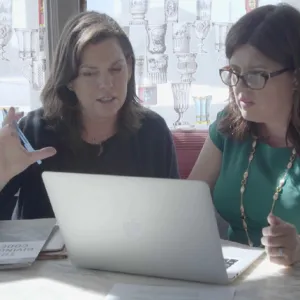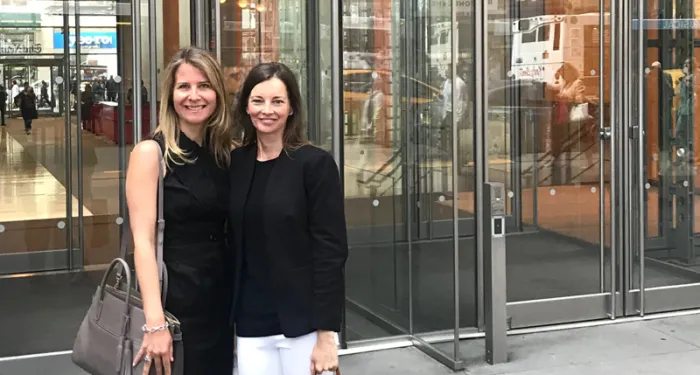
Lindsay Beck and Catarina Schwab
A Radical Idea So Nonprofits Can Do More: NPX Advisors
Lindsay Beck and Catarina Schwab want to help nonprofits think bigger, better and crazier. They’re doing it by making fundraising so much smarter.
One thing that's become obvious to me, from several years of doing this podcast, is the biggest frustration for those who help others.
It's fundraising — the illogic, the inefficiency, and sometimes, just the plain stupidity of it.
Why do I say it's stupid? As you'll hear in today's show, sometimes, as a nonprofit gets better at the work they do, they'll receive less funding from donors.
In other cases, the resources they receive aren't tied to their impact at all. Instead, the organization's survival depends on its ability to throw big fundraisers or galas.
It's a system that makes no sense. And the women we'll speak with in this episode are out to change it.
About Lindsay Beck and Catarina Schwab
Their names are Lindsay Beck and Catarina Schwab, and they're the co-founders and co-CEOs of NPX Advisors.
I think you'll be impressed by their tremendously creative ideas.
One, called an Impact Security, and allows people to invest in the work of a nonprofit in a manner similar to investing in a business. In return, the nonprofit gets far more resources, and the ability to think bigger, better, and crazier over the long term.
But I think you'll be even more impressed by Lindsay and Catarina's personal stories. Each of their lives took several crazy turns to lead them where they are now.
For example, when diagnosed with cancer at a young age, Lindsay turned the fight for her life into a mission that helped millions of others — and changed the whole medical system for young people facing such a disease in the process.
So, without further ado, here is the interview.
CATARINA SCHWAB: Thank you, Frank.
LINDSAY BECK: Thank you.
FRANK BLAKE: Well, it's great to have you on the podcast. You both have amazing backgrounds. You achieved great accomplishments before you started NPX. So let me start with this question:
What got you into the helping-out-others business to begin with?
CATARINA SCHWAB: So, I've had a lot of turns, and none was really predicted too far out. I really started my career squarely in for-profit, in investment banking and venture capital both in Europe and in the States. Then I worked for one of our portfolio companies, and had some success in some of those investments. So then I had my own capital to start my own business and actually had a retail business for five years. Snd then got to the nonprofit sector.
I would say that it was a bit random in that I wasn't necessarily thinking, "My next step is going to work for a nonprofit." But I had been involved with buildOn for a really long time. It had really been a family affair.
So, buildOn is empowering youth through service here. It's through after school service programs in inner city high schools. Overseas, it's building schools in developing countries.
They said to me, "We're looking for someone to run our development on the West Coast. You've been there for a long time. Can you help us find someone?" And someone said to me I ended up hiring myself. Because, next thing I knew, I was in the office with a computer and got really, really into it. So, for the next five years, I headed up that effort based out of San Francisco and loved it, brought my kids into it.
So, I now have a 12 and 11-year-old who have been inside most high schools in the Bay Area with me. I found that was a great icebreaker. These high school kids would talk to me if I had a two or four-year-old with me.
I've done multiple service projects throughout the Bay Area, and then built schools in Nicaragua, Malawi, and Nepal — none of which was directly related to my job. My job was to raise capital and raise awareness, but I felt it was really important to literally get into the trenches, to know the power of our work.
FRANK BLAKE: That's great. And Lindsay?
LINDSAY BECK: Yes. I guess my first crazy good turn was being diagnosed with cancer.
That sounds ironic, because you wouldn't think that's a crazy good turn. But shortly out of college, I was a young adult diagnosed with cancer the day after running a marathon. Thought it was the healthiest I had ever been. To my great surprise, I was actually the sickest.
Growing through my treatments, I lived a problem. I lived a profound void in the treatment of young adults with cancer, and that was sterilization.
At the time, cancer patients were being sterilized — without their knowledge or permission — by cancer treatment.
Chemotherapy, radiation, and surgery can sometimes be sterilizing. But patients weren't getting told that in advance of treatments. That seemed crazy to me as a young 22-year-old facing my own mortality and my own treatment plans.
I personally uncovered this risk. I was able to freeze my eggs in advance of treatment, preserve my fertility, and go through treatments knowing that if I survived, I would be able to live the life of my dreams and become a mother. In doing that and experiencing that void, I realized this was a solvable problem for other people and that someone needed to solve it. So, I started a nonprofit organization with that goal.
Its name was Fertile Hope, and our goal was to do two things. One, make sure every patient was informed of their risks. And two, increase access to treatments so that patients could preserve their fertility before undergoing these potentially sterilizing treatments. I'm thrilled to say that, over time, we were able to achieve those goals.
It is now the standard of care in the US to inform your patients, which means that if you don't inform them, you're at risk of malpractice. We were able to rewrite the medical standard of care there.
Then, two, we were able to transform insurance coverage around the country so that millions of people have coverage for fertility preservation when they're facing sterilizing medical treatments.
FRANK BLAKE: Wow.
LINDSAY BECK: I now have four children, so my own personal dreams came true. I often forget to say that and people leave feeling sorry for me. But in doing that, in that case, I lived the problem, I lived the solution, and I wanted to bring that solution to others. In fact, I felt guilty not doing so. I felt like, "Gosh, this is solvable and I know this. Why doesn't everyone know this and have access to it?"
Undoing that and running a small high-impact nonprofit, I lived another problem: The fundraising problem.
I lived on that annual fundraising treadmill. Often, there's an inverse relationship between money and impact. The more successful we became, the harder it was to raise money. Our donors would say, "Gosh, you guys are doing so well. You don't need our money. We will give it to a nonprofit that needs it more."
That seemed counterintuitive to me. It was not how the for-profit world works.
So, I think that's where my second crazy good turn came is I thought, "Gosh, I'm a problem-solver, I've lived this problem. There has to be a solution. Where and how can I figure out who else is thinking about this, working around this, and trying to solve it?"
So I decided to go to business school. I went to Wharton to study finance and really step back and learn, listen and understand the market. That's what led me to begin thinking about NPX and where the initial ideas around Impact Security were born. That led to my third crazy good turn, which was meeting Catarina and taking that academic journey I had been on and turning it into an entrepreneurial journey. We started the company and are now bringing this to the world.
FRANK BLAKE: Those are both amazing arcs of stories.
CATARINA SCHWAB: There have been a lot of pivotal moments along the way. Lindsay and I both have backgrounds in for-profit and nonprofit. So we came to the problem of how nonprofits are raising capital in different ways.
The pivotal moment, for me, was meeting Lindsay for the first time, and she had already been hard at work on what has turned into so much more at NPX.
After buildOn, where I was the head of development for five years on the West Coast, I was really focused on trying to find a better way for nonprofits to raise capital. I wanted it to be based on impact, not on their ability to throw a fabulous gala every year, or beg, borrow, and plead for capital every single day
I think I was just talking about it to anyone and everyone. A mutual friend of ours said, "I hear what you're saying and I wish I had a solution for you. But one of my great friends is running around, talking about the same problem. So I think you should meet." So we had a lunch where this mutual friend invited us both over, and we told our stories.
When Lindsay told us what she was working on, and it was just that moment for me. Someone describes it as, "When the flame is lit." It felt like that. It was like, "Oh, my gosh. What is … This is incredible. This is what I've been looking for."
FRANK BLAKE: Very cool. Lindsay, pretty much the same answer?
LINDSAY BECK: Absolutely. Then, I flashed to other scenes where the flame continued to grow. Like in a conversation with the executive director of a nonprofit who put up her hands and cheered and said, "Wow. You have reinvented fundraising for nonprofits." Or when we meet with donors and empathize with the tough position they're in, and they get tears in their eyes when they see the merit of a new way that helps more people and lets them feel good about what they're doing.
FRANK BLAKE: Maybe this is a good time for you to describe how NPX works because I think it really is brilliant and creative.
CATARINA SCHWAB: Great. Yes. So, as you said in the beginning, our vision, NPX's vision, is to transform how nonprofits are funded. To do that, we developed a new financial product called the Impact Security. It brings together donors and investors to fund nonprofits in a new way.
Our first Impact Security deal was launched last May. It was with a group of 16 donors led by Richard Branson's Virgin Unite, the San Francisco Foundation, Giving Pledge members Gordon and Lulie Gund, and a number of other individuals and foundations and 11 investors led by Omidyar Network, Duncan Niederauer, the former CEO of the New York Stock Exchange. That first Impact Security with those donors and investors was to fund The Last Mile, which is teaching coding inside prisons.
FRANK BLAKE: Yeah. We actually featured them on a podcast back last year. Yeah.
CATARINA SCHWAB: Yes. Which was totally random, Frank. We met Frank through someone else. And then, as I was looking at the Crazy Good Turn's various episodes, of which I've gotten through quite a few and I'm definitely going to listen to all of them because they've each been amazing, I saw The Last Mile there. So, very serendipitous.
So, they've been running this program to teach coding inside US prisons for a number of years. This particular financing was to fund the first-ever web development shop inside a prison. Lindsay and I have spent a lot of time in San Quentin as we were getting to know this program so that we could really understand. We always ask a nonprofit three questions. We say, "What impact are you trying to achieve, how much capital do you need, and over how much time?"
CATARINA SCHWAB: This is very different than what nonprofits are being asked today. In fact, this nonprofit was about to plan a gala and was really quite hesitant to do so. They were seeing the impact, and so they were really drawn to our model. As you can imagine, since they haven't been asked the questions of, "How much money do you need," and, "Over how much time?"
We're really moving beyond the one-year cycle. They turned to us and said, "How much is available?" and we said, "No. This is really your opportunity to build a use of proceeds that will allow you to shoot for the moon and to achieve the impact that you're trying to achieve." So, the Impact Security allows for that.
FRANK BLAKE: Describe how that project worked and how the Impact Security, how that gets funded and then dispersed.
LINDSAY BECK: Sure. Happy to explain how it works. So, the funding vehicle is called the Impact Security. As Catarina said, it brings together donors and investors to fund nonprofits based on their impact.
To clarify, we use the term donor and investor very intentionally. When we say, "Donor," we mean someone who wants to make a donation. And when we say, "Investor," we mean someone who wants to earn a financial return. It's really important to clarify that because a lot of nonprofits now call their donors investors and it makes things very confusing.
So, with the Impact Security, it allows a nonprofit to issue performance-based debt and then repay that debt over time with donations. So, what happens is a group of donors contributes to what's called a donor impact fund and a separate group of investors buy this debt from the nonprofit.
On day one, the nonprofit issues debt and receives money from investors. So, they have all the money they need upfront to run the program over a long time frame. Over time, the nonprofit achieves and reports out on the impact. As they achieve units of impact, that triggers the donor impact fund to repay the investors, to make their donation and repay investors.
So, if an organization achieves all of its impact over time, the donors buy those units of impact, and that is used to repay investors. If an organization falls short of its impact target, investors may lose some or all of their investment. The donors then are able to redeploy or recycle the remaining donations to other nonprofits of their choosing.
The simple structure in terms of bringing these different groups together has a unique value proposition for each participant.
Nonprofits have access to new sources of capital. They're able to raise more money over longer timelines at a lower cost of capital, and really focus on impact.
Investors have more opportunities to invest in impacts. It's a product that explicitly links their financial returns with impacts.
Then donors get to move from the traditional model of diligence, donate, and hope. The more impact that happens, the more they donate, and vice versa. All of that allows us to have a more efficient and transparent market with accountability and transparency around what's working, what's not, and learning and growing from there.
FRANK BLAKE: So, your focus and your ability through this to focus on impact sounds so powerful and so straightforward. But I suspect it's not as straightforward as it sounds or not as easy as it sounds. Is it?
CATARINA SCHWAB: In terms of impact, it really used to be the red herring. People would say, "How do you measure impact? Who decides what the right impact is, the right level of impact?" So, we've come a long way, both as NPX with our ability to structure Impact Security deals, and also, the sector. There's many more impact evaluators, auditors, people from university groups. So, people are really thinking deeply about this, even at an organization that we partner with called Impact Genome Project.
I won't say, "It's easy." There is a lot of time that we spend with the nonprofits to really figure out what impact they are trying to achieve, and there is always a spectrum.
The Last Mile's a good example. So, their impact spectrum is from impact outputs, or the number of incarcerated individuals who now know how to code and go through their program, all the way to recidivism, or people not re-offending and going back to prison. Where we settled for this first Impact Security.
And I say, "First Impact Security," because we do believe there will be more, and that impact metric could be different as they move along this spectrum and as they grow. Where we settled was hours worked in the dev shop because — it's going to sound really simple — but after a lot of work, we realized that would really show or prove success because you could only hit hours worked if you've trained enough individuals to know how to code at that level and secure the job contracts to hit those hours.
So, that was the impact metric for the first deal. The group of donors and investors all signed off on it, and we actually just reported really positive results. It's a year after, and so investors actually just last week got repaid on this deal, which is super exciting.
FRANK BLAKE: Oh, wow. That's very cool.
CATARINA SCHWAB: But they still have zero percent recidivism. People are actually not only learning how to code in prison, they're getting paid the highest wage. That represents cost savings to the prison system, increased personal savings for them for when they do get out. Most inmates, when they get out, have $200. When you're getting paid $17 versus the next best-paying job of just under a dollar, you have a lot more money when you get out. That obviously helps your ability to not re-offend.
And they're getting jobs. Some are getting paid six-figure salaries at some of the great tech companies. So, there are still eyes on the recidivism impact metric. At the time when we structured the deal, we didn't feel like they controlled that metric as much as they needed to, but they are getting there. So, it's a lot of work, but there's been a lot of progress.
LINDSAY BECK: I would add that when we are in the board room or a theoretical discussion around impact, it does seem big and messy and insurmountable. But when we are in a room with the nonprofits, we've never met a nonprofit that doesn't know what they're currently measuring, what they wish they could be measuring, what their peers are measuring. They aren't unclear on the goal at hand, what they want to solve, or what they want to move the needle on. So, we find, when we get out of the theoretical and into the practical, it makes it easier and very clear for us and for them.
FRANK BLAKE: So, is that learning about focus more something that applies to the donor/investors than to the charitable organization itself?
CATARINA SCHWAB: Absolutely.
FRANK BLAKE: Yeah. So, it's more getting the donor and investors to understand and focus on, "Well, what do you expect on an impact from your investment or donation?"
LINDSAY BECK: And alignment, right? So, The Last Mile's Impact Security had 27 participants, and in a traditional fundraising model, that would have meant 27 different reports on 27 different timelines on, likely, 27 different metrics, all of which the donors wanted a report on as opposed to … In our case, it's one report once a year on the core impact metric that the nonprofit cares most about, and that is transformative for the nonprofit.
CATARINA SCHWAB: As we built that business case and settled on or determined the impact metric and went to those 27 participants, not one had any issue with it. They all agreed that that was the right impact metric. So, as much as one might think the donors and investors want to be at the table figuring that out, if you've gone through the process, they approve and they are thrilled now to all get this report with one impact metric and some more details on what's happened over the last year. But they're all looking at one metric, and money moves based on that metric.
FRANK BLAKE: One of the quotes attributed to you, that I think seems profound is, "The way you fund impact determines what impact is possible." Could you go in a little deeper into that because that seems to be right at the heart of what you're doing?
LINDSAY BECK: Absolutely. I think that donors don't realize, often, the power seat that they're in. If you fund small amounts over short timelines, by default, the nonprofit is hamstrung and won't get as much done. The way we fund nonprofits is not the way we fund for-profits. I think that comes down to this broken model of a donor only has one option: varying levels of due diligence, donate, and then hope for impact. Because you can't control the backend, the impact part, you try to control what you can.
So, you try to do more diligence or you try to move the other levers you have, which is amount of money and timelines for money. What it means is that it's hard to let go and trust and give huge amounts over long timelines when you're just hoping for the impact on the backend.
So instead we end up limiting what the nonprofits are capable of because they're on this annual fundraising treadmill. They're getting small amounts of money over one-year timelines. It just simply isn't working.
FRANK BLAKE: I think that's such an important point. We had Dan Pallotta on the podcast a while back, and you know his comments on why nonprofits haven't gained scale. But this seems like a potential answer to that.
CATARINA SCHWAB: Yeah. We've spoken to him over the years, just reconnected with him a few weeks ago, and he was thrilled to hear of the progress. The hardest part of all this has actually been change of behavior for donors.
People say, "Wow. This is an incredibly elegant solution," so you think, "Great. We have an elegant solution. We've done the work. We've talked to the three different parties of nonprofits, donors, investors. They all want this," and then you think, "Wait. Why is this taking longer than we thought to get it done?"
For the nonprofits, the pain point is so high. They are thrilled to have this new development tool in their toolbox. For investors, it's the shiny, new toy. It's an impact investing product that explicitly links your capital with impact.
For donors, they are in the sweetest seat. Instead of hoping, now your money only moves when impact happens. But your pledge to donate catalyzes this new investment capital and sets the nonprofit up for success. But it is a change of behavior.
FRANK BLAKE: One of the phrases that always sticks in my mind is that the end result shows the dominant motive.
I wonder, sometimes, with the way we approach nonprofits, whether there isn't some part of us that wants the gutsy fundraiser or wants to be powerful on boards, dolling out money timorously rather than with an eye to long-term impact. But maybe that's too cynical a way of looking at this.
CATARINA SCHWAB: No. We think we really have a solution here, and so you can be a little bit blinded. We've been in meetings where we're talking about impact and we walk out and think, "I think that person's definition of impact is different than ours." So we recognize that those might not be our pioneers. But we also have found so many people that have the same definition.
We've been in rooms with 10 plus foundations who have told us outright, "Our biggest grant-making challenging is that we don't know if it's working, and we really need it to work." So over the years and in so many meetings, we have met people who really are aligned with us and really feel like we're getting a lot of traction right now.
LINDSAY BECK: I also think, Frank, to your point: A lot of philanthropy, for better or worse, is tied to ego. Or hurt. Or passion. In addition to tax benefits. It's messy, right? It's a mix of finance and emotion. I think it's easy to say, "It's all one or all the other," when, really, it's okay that it's in the middle. So, even with the Impact Security, we are trying to meet people where they are. If what's most important to you is your name and lights, you can still do that and link the money to impact. It isn't mutually exclusive, right?
FRANK BLAKE: Right.
LINDSAY BECK: It doesn't have to be head or hurt, I can be head and hurt, and it should be. So we don't have to remove that piece of it. But we do need to add the impact piece. Because right now there are hundreds of millions of dollars being deployed into the sector and it's not linked to data. We don't know what's working and what's not. We're not learning from that the way the for-profit world does. That's at the expense of human lives and the environment.
FRANK BLAKE: So, what's the big project that you're working on now or projects?
CATARINA SCHWAB: Yes. So out of that listening tour, we learned a lot. We met with over 60 philanthropists, individuals, and foundations, and it sort of boiled down to three things. The first is that, no matter who you are, even if you're the largest foundation, you don't have enough money to solve the issues that you care about.
Number two that some of those large foundations do have massive teams working on this. But it's really hard to feel like you have access to high quality data. Setting up that diligence process is really overwhelming to a lot of people. Then, lastly, as I said in these rooms with the foundations, that there's a real frustration that money isn't linked to impact and they don't know if it's working or not.
So, we took those three things and developed our second product that's called a donor impact fund, or a DIF. We're saying, "DIF," because we found it really helpful to ground people in what else is out there and the alternatives. So, the DIF is really an alternative or even complementary to a DAF, which many people know, the donor-advised fund. The donor-advised fund is a great financial decision. You get the "tax-minimization strategy" if you put your capital into a DAF. How we've seen people use DAFs are really more like a charitable checking account.
So, the DIF deploys capital through our Impact Security, so it's different from a DAF in a few ways. A DIF will be focused on an issue area, education, homelessness, criminal justice, economic opportunity, an issue area or a geography, it will activate capital within the first two years of us structuring deals. Impact Security deals in the form of pledges, and it will link that capital to impact.
Your money won't leave a DIF until impact happens, but your pledge would catalyze investment capital, which does fund the nonprofit on day one. So, this DIF model has really resonated with people. I think, one, we listened, and then we're going back to these people to say, "This is the product we're talking about." And we have had 100 percent, "Yes," to let's keep going and see what this really looks like.
FRANK BLAKE: Okay. All right. Okay. So, let me end this with a question that ties back to the beginning. If you're now five years forward and filming the scene at the end of the movie that shows your grand accomplishment or symbolic accomplishment of what NPX has accomplished over the last five years. What's in that scene?
CATARINA SCHWAB: I see a huge celebration. If you think of one DIF for economic opportunity in Atlanta, say it's $100 million, that's 10 nonprofits who reach 500, 1,000. The multiplier effect can be huge. It is really our why. It is really why we're doing this. We want nonprofits to have the money they need to achieve the impact that the world needs to see across so many issues.
We are in a time of crisis, and we really need a new mechanism. We try not to bore the people with the details of the financial product. They don't even really need to know that. They need to each know their role of, "We need to unlock the capital, the philanthropic capital. This is a better way. We need to give nonprofits a new tool to raise capital." There's a growing amount of impact-investing dollars out there that are looking for the double-bottom line. So, there is a strong value proposition. There is great desire from all those parties to achieve more impact, and we can do it together.
LINDSAY BECK: To layer on to that visual of a celebration, imagine almost like a Bloomberg or a stock ticker where billions of dollars are moving — and they're moving tied to impact.
Some of those charts are going up and up and more money is flowing to them. And we're in the room celebrating with the people who are benefiting from those programs that are working. Other charts are going down, and those programs aren't working. We're learning fast and shutting them down so that we can apply resources to the ones that are working.
So that real visual — billions of dollars moving, and moving tied to impact, so that we can more quickly get to what works and scale it — is what we want to see.
FRANK BLAKE: Again, I just think the idea, the concept you have come up with is so powerful and so important. I think you can make such a difference for so many people. I applaud you for all the energy and effort that it takes to keep moving it forward. Congratulations on the success you've gotten so far. For our listeners, where should they go to learn more?
CATARINA SCHWAB: First of all, thank you, Frank. That means a lot to us. So, thank you. The best place is NPXAdvisors.com. We also are on social media. I think our channel of choice is LinkedIn, both for NPX Inc. and our individual Catarina Schwab and Lindsay Beck. It's where we found that we can get the most reach, the most thoughtful dialogue with the people who care about what we're trying to do.
FRANK BLAKE: Fantastic. Well, thank you again. Thank you for joining us, and look forward to your continuing progress. Thanks.
CATARINA SCHWAB: Thank you.
LINDSAY BECK: Thank you.
